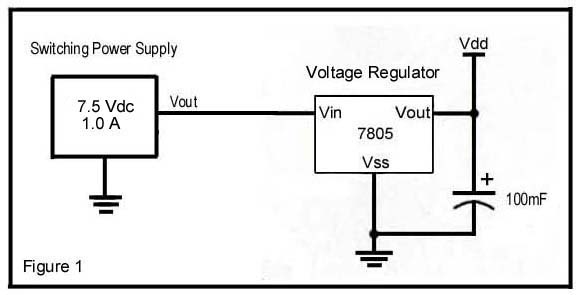Voltage Regulator and Capacitors
Hello everyone, I have a question regarding what the capacitor's on the input and output side's of the voltage regulator do. I have looked over the regulators data sheet and still haven't come to any kind of conclusion other than for stabilization·of certain kind of regulator circuits. I have attached a schematic of my power supply and regulator circuit. I'm using this circuit now in my project and it has been working without any flaws for many months.·My supply/regulator circuit is powering a BS2P24 that's running basically four Led's. Is my power supply and regulator circuit ok to run this way ?
Thank you for your help....
Twisted Pair....
Thank you for your help....
Twisted Pair....




Comments
The capacitor on the output side serves two purposes: 1) It supplies current at the regulated voltage when there's a sudden demand from the logic circuit while the regulator attempts to compensate. 2) It may be required for proper regulator operation. The datasheet for the regulator will indicate the minimum capacitance required.
In general, follow the manufacturer's recommendations. In most cases, you want several hundred microFarads on the output side in parallel with a 0.1uF to 1uF capacitor on both input and output sides of the regulator.· If your circuit does not have large current spikes, you can go with the minimum output capacitor size recommended by the manufacturer.
Twisted Pair....
Leon
▔▔▔▔▔▔▔▔▔▔▔▔▔▔▔▔▔▔▔▔▔▔▔▔
Amateur radio callsign: G1HSM
Suzuki SV1000S motorcycle
Post Edited (Leon) : 3/15/2008 3:03:49 PM GMT
Would it hurt anything to greatly exceed the recommended ratings?
For example, if a 1uF is called for, would it be alright to use a 1000uF?
1) Some few specific models of regulators have limits on the size of the capacitor. Always check the datasheet.
2) With very large capacitors, the surge current (to initially charge them) is pretty high and might cause the
regulator to shut down briefly. We're talking here probably about well over 1000uF values.
3) Sometimes the large value electrolytics have enough inductance or resistance that their RC or LC time is
too high for regulator stability. You probably need a small (like 0.1uF or 1uF) capacitor in parallel with the
larger capacitor and very close to the regulator.
Now that you've listed the disadvantages of just using a 1000uF cap... are there any advantages of exceeding the
datasheet's min value by about that much?
Thanks Mike!
▔▔▔▔▔▔▔▔▔▔▔▔▔▔▔▔▔▔▔▔▔▔▔▔
- Rick